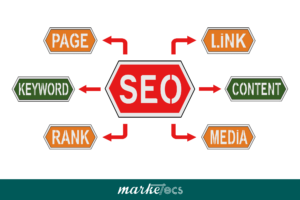Key takeaways:
- What is SEO?
- Why SEO Matters & How You Benefit
- 7 Simple Steps to SEO Success
- Maximize Your Content
- Need Help Getting Started?
Officially, it’s called “Search Engine Optimization.”
You can just call it SEO for short, and it can revolutionize your business if you do it right.
Stay with us as we give you a quick primer on this tried-and-true practice – and how you can implement some smart tips starting today…
So what is SEO, exactly?
“On a broad scale, I see SEO becoming a normalized marketing tactic, the same way TV, radio, and print are traditionally thought of as marketing tactics.”
– Duane Forrester, Former Senior Product Manager, Bing
Although millions of webpages, an untold number of books, and countless workshops and seminars have been created to teach SEO, the gist of it is pretty simple: SEO is a set of practices that just about anyone can use to help certain web pages rank higher in search results. In other words, SEO can help you get found.
Why SEO Matters to Every Coach, Consultant (or any Business Owner)
That’s pretty straightforward too. Stronger traffic to your website can translate into greater visibility and increased revenue.
Specifically, good SEO practices can benefit your business in several key ways. It can:
- Generate leads in a cost-effective way
- Build stronger brand awareness & trust
- Put you in the lead, ahead of your competition
- Help optimize your site for mobile users
- Inspire improvements to your other marketing tactics
- …and more!
7 Simple Tips to SEO Success for Every Business Owner
SEO doesn’t have to be daunting. Incorporate the advice below and you’ll find that Search Engine Optimization is approachable – and achievable.
Start small. It’s easy to get overwhelmed trying to figure all the nuts & bolts of SEO out, but even some seemingly small changes to your website can have a measurable impact. You don’t need a huge corporate budget, or lots of time/expertise to make some simple, practical changes.
Here are some tips:
- Know who your users are. You might think of your users as being clients/customers – or potential ones. Of course, this is true – but it’s only a part of the picture. Google’s SEO Starter Guide reminds us that an often-overlooked user is the search engine itself. Without it, your real-life users can’t find your content.
- Don’t overlook the obvious. It’s amazing how easy it is to overlook the simplest things – like ensuring your website is even in Google’s index. To find out if yours is, do a site search for your site’s home URL (for ex: type site:wikipedia.org in Google). See results? Yay! You’re in the index. No? Keep reading…
- Site missing from Google? Figure out why. Common reasons your site was missed include: it’s new and Google simply hasn’t had a chance to crawl it yet, an error prevented access, or site design makes it difficult for Google to crawl the site. Many other reasons are here, and how to fix the issue.
- Create a sitemap if you haven’t already. Considered to be one of the most crucial elements of SEO, a sitemap is a file where you provide information about your site content that is read by search engines. Sitemaps are beneficial because they can assist search engines to crawl your site more efficiently. Not sure where to start? Google has some excellent sitemap resources here. If you have a WordPress website, a simple plugin can help take the time & guesswork out of creating a sitemap. Here are some plugin suggestions to consider.
- Go beyond SEO. Combine SEO improvements with other website optimizations and watch the magic happen. Improving things like page load times and reducing bulky image sizes can positively impact your visitors’ experience, and give you a boost in organic search results.
- Stay up to date. In the world of SEO, things change all the time. What was once considered an SEO best practice might quickly become obsolete. Stay on top of the game by keeping in the know so you can adapt your practices accordingly as needed.
You’ve Got Content…Use it to Maximize SEO!
Chances are (even if you don’t think so), you have lots of content that you can leverage for SEO purposes. Sometimes all it takes is a few simple tweaks to refresh your blog posts to maximize search engine optimization (SEO), readability, and user engagement.
Some simple blogging pointers:
- Remember those keywords! Incorporate your top key words and phrases throughout a post, including in the title and sub-titles, at the beginning and at the end of your post, and in your metadata.
- Add useful inbound & outbound links to provide extra value to your reader and boost the validity of your content, which can help you rank higher in search results.
- Include at least one picture in each blog post. Add ‘alt text’ to each image; this is the ‘alternative text’ that Google will read and will appear in case the picture is not available.
- Insert headings that feature your most relevant keywords & phrases. These also help guide your reader through the post and provide a visually organized format.
- Consider using lists. Bullet points are a great way to make text stand out. Use them to draw your reader’s attention to key points.
Need some creative ideas to breathe life into your existing content? Not only is it a great way to offer up your content in a fresh way, it can also be a major time saver. Try these 7 ways to repurpose your content.
Most importantly, know that SEO isn’t a once-and-done practice. Rather, like any smart marketing strategy, you need to do your research, stay current, analyze your current practices, tweak…then rinse & repeat. And stay tuned for our next article, where we’ll give you 5 ways AI is already impacting SEO.
If the thought of SEO feels overwhelming (or you just don’t have time for it), help is right here! Schedule a call to chat with a digital marketing expert.


